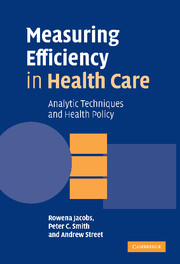Book contents
- Frontmatter
- Contents
- List of figures
- List of tables
- Preface
- Acknowledgements
- List of abbreviations
- 1 Efficiency in health care
- 2 The components of an efficiency model
- 3 Stochastic frontier analysis of cross-sectional data
- 4 Stochastic frontier analysis of panel data
- 5 Data envelopment analysis
- 6 The Malmquist index
- 7 A comparison of SFA and DEA
- 8 Unresolved issues and challenges in efficiency measurement
- 9 Some alternative approaches to measuring performance
- 10 Conclusions
- Appendix: Data description
- References
- Author index
- Subject index
4 - Stochastic frontier analysis of panel data
Published online by Cambridge University Press: 10 December 2009
- Frontmatter
- Contents
- List of figures
- List of tables
- Preface
- Acknowledgements
- List of abbreviations
- 1 Efficiency in health care
- 2 The components of an efficiency model
- 3 Stochastic frontier analysis of cross-sectional data
- 4 Stochastic frontier analysis of panel data
- 5 Data envelopment analysis
- 6 The Malmquist index
- 7 A comparison of SFA and DEA
- 8 Unresolved issues and challenges in efficiency measurement
- 9 Some alternative approaches to measuring performance
- 10 Conclusions
- Appendix: Data description
- References
- Author index
- Subject index
Summary
Introduction
The previous chapter discussed econometric approaches to efficiency analysis when only cross-sectional data are available. Along with general issues of specifying the estimation model, particular attention was drawn to the interpretation placed on the residual and the assumptions required in order to extract estimates of efficiency. Some of the strong assumptions required for efficiency analysis based on cross-sectional data may be relaxed if longitudinal data are available, with organisations observed over several time periods. Repeated observations of the same organisation make it possible to control for unobservable organisation-specific attributes and, thereby, to extract more reliable parameter estimates, both of the explanatory variables and of the efficiency term. Specifically three shortcomings of cross-sectional analysis can be addressed (Schmidt and Lin 1984).
First, recall from the previous chapter that, when only a single observation is available per organisation, it is necessary, in order to partition the composite error term, to specify how inefficiency is distributed among organisations. Standard software allows analysts to choose truncated normal, half-normal, exponential and gamma distributions. However, there is no economic basis for selecting one distribution over another and the choice is somewhat arbitrary (Schmidt 1985). Repeated observations of the same organisation can substitute for distributional assumptions if the fixed-effects panel data estimator is used.
Second, under some formulations of the production model the inefficiency term, ui, and the explanatory variables, xi, are unlikely to be independent.
- Type
- Chapter
- Information
- Measuring Efficiency in Health CareAnalytic Techniques and Health Policy, pp. 69 - 90Publisher: Cambridge University PressPrint publication year: 2006



